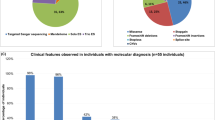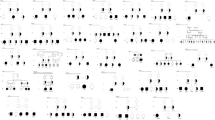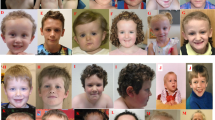Abstract
Intellectual disability (ID) affects 2–3% of the population. In the past, many genetic causes of ID remained unidentified due to its vast heterogeneity. Recently, whole exome sequencing (WES) studies have shown that de novo variants underlie a significant portion of sporadic cases of ID. Applying WES to patients with ID or global developmental delay at different centers, we identified three individuals with distinct de novo variants in HIVEP2 (human immunodeficiency virus type I enhancer binding protein), which belongs to a family of zinc-finger-containing transcriptional proteins involved in growth and development. Two of the variants were nonsense changes, and one was a 1 bp deletion resulting in a premature stop codon that was reported previously without clinical detail. In silico prediction programs suggest loss-of-function in the mutated allele leading to haploinsufficiency as a putative mechanism in all three individuals. All three patients presented with moderate-to-severe ID, minimal structural brain anomalies, hypotonia, and mild dysmorphic features. Growth parameters were in the normal range except for borderline microcephaly at birth in one patient. Two of the patients exhibited behavioral anomalies including hyperactivity and aggression. Published functional data suggest a neurodevelopmental role for HIVEP2, and several of the genes regulated by HIVEP2 are implicated in brain development, for example, SSTR-2, c-Myc, and genes of the NF-κB pathway. In addition, HIVEP2-knockout mice exhibit several working memory deficits, increased anxiety, and hyperactivity. On the basis of the genotype–phenotype correlation and existing functional data, we propose HIVEP2 as a causative ID gene.
Similar content being viewed by others
Log in or create a free account to read this content
Gain free access to this article, as well as selected content from this journal and more on nature.com
or
References
Wu L-C : ZAS: C2H2 zinc finger proteins involved in growth and development. Gene Expr 2002; 10: 137–152.
Dörflinger U, Pscherer A, Moser M, Rümmele P, Schüle R, Buettner R : Activation of somatostatin receptor II expression by transcription factors MIBP1 and SEF-2 in the murine brain. Mol Cell Biol 1999; 19: 3736–3747.
Fukuda S, Yamasaki Y, Iwaki T et al: Characterization of the biological functions of a transcription factor, c-myc intron binding protein 1 (MIBP1). J Biochem 2002; 131: 349–357.
Iwashita Y, Fukuchi N, Waki M, Hayashi K, Tahira T : Genome-wide repression of NF-κB target genes by transcription factor MIBP1 and Its modulation by O-Linked β-N-acetylglucosamine (O-GlcNAc) transferase. J Biol Chem 2012; 287: 9887–9900.
Nakayama T, Kimura MY : Memory Th1/Th2 cell generation controlled by Schnurri-2. Adv Exp Med Biol 2010; 684: 1–10.
Staton TL, Lazarevic V, Jones DC et al: Dampening of death pathways by schnurri-2 is essential for T-cell development. Nature 2011; 472: 105–109.
Yamashita J, Iwamura C, Mitsumori K et al: Murine Schnurri-2 controls natural killer cell function and lymphoma development. Leuk Lymphoma 2012; 53: 479–486.
Saita Y, Takagi T, Kitahara K et al: Lack of Schnurri-2 expression associates with reduced bone remodeling and osteopenia. J Biol Chem 2007; 282: 12907–12915.
Jin W, Takagi T, Kanesashi S et al: Schnurri-2 controls BMP-dependent adipogenesis via interaction with Smad proteins. Dev Cell 2006; 10: 461–471.
Rauch A, Wieczorek D, Graf E et al: Range of genetic mutations associated with severe non-syndromic sporadic intellectual disability: an exome sequencing study. Lancet 2012; 380: 1674–1682.
Petrovski S, Wang Q, Heinzen EL, Allen AS, Goldstein DB : Genic intolerance to functional variation and the interpretation of personal genomes. PLoS Genet 2013; 9: e1003709.
Arora K, Dai H, Kazuko SG et al: The Drosophila schnurri gene acts in the Dpp/TGF beta signaling pathway and encodes a transcription factor homologous to the human MBP family. Cell 1995; 81: 781–790.
Staehling-Hampton K, Laughon AS, Hoffmann FM : A Drosophila protein related to the human zinc finger transcription factor PRDII/MBPI/HIV-EP1 is required for dpp signaling. Dev Camb Engl 1995; 121: 3393–3403.
Kingsley DM : The TGF-beta superfamily: new members, new receptors, and new genetic tests of function in different organisms. Genes Dev 1994; 8: 133–146.
Patel YC : Somatostatin and its receptor family. Front Neuroendocrinol 1999; 20: 157–198.
Pelengaris S, Khan M, Evan G : c-MYC: more than just a matter of life and death. Nat Rev Cancer 2002; 2: 764–776.
Wey A, Knoepfler PS : c-myc and N-myc promote active stem cell metabolism and cycling as architects of the developing brain. Oncotarget 2010; 1: 120–130.
Kaltschmidt B, Kaltschmidt C : NF-kappaB in the nervous system. Cold Spring Harb Perspect Biol 2009; 1: a001271.
O’Neill LA, Kaltschmidt C : NF-kappa B a crucial transcription factor for glial and neuronal cell function. Trends Neurosci 1997; 20: 252–258.
Takao K, Kobayashi K, Hagihara H et al: Deficiency of schnurri-2, an MHC enhancer binding protein, induces mild chronic inflammation in the brain and confers molecular, neuronal, and behavioral phenotypes related to schizophrenia. Neuropsychopharmacolgy 2013; 38: 1409–1425.
Takagi T, Jin W, Taya K, Watanabe G, Mori K, Ishii S : Schnurri-2 mutant mice are hypersensitive to stress and hyperactive. Brain Res 2006; 1108: 88–97.
Acknowledgements
We thank the patients and their families for their patience and time. This work was supported in part by the German Ministry of Research and Education (grant numbers 01GS08164, 01GS08167, 01GS08163, German Mental Retardation Network/MRNET) as part of the National Genome Research Network.
Author information
Authors and Affiliations
Corresponding author
Ethics declarations
Competing interests
The authors declare no conflict of interest.
Rights and permissions
About this article
Cite this article
Srivastava, S., Engels, H., Schanze, I. et al. Loss-of-function variants in HIVEP2 are a cause of intellectual disability. Eur J Hum Genet 24, 556–561 (2016). https://doi.org/10.1038/ejhg.2015.151
Received:
Revised:
Accepted:
Published:
Issue date:
DOI: https://doi.org/10.1038/ejhg.2015.151
This article is cited by
-
Comprehensive genetic analysis confers high diagnostic yield in 16 Japanese patients with corpus callosum anomalies
Journal of Human Genetics (2021)
-
The genomic basis of mood instability: identification of 46 loci in 363,705 UK Biobank participants, genetic correlation with psychiatric disorders, and association with gene expression and function
Molecular Psychiatry (2020)
-
Functional CRISPR dissection of gene networks controlling human regulatory T cell identity
Nature Immunology (2020)
-
Identification of HIVEP2 as a dopaminergic transcription factor related to substance use disorders in rats and humans
Translational Psychiatry (2019)
-
Transcriptomic immaturity inducible by neural hyperexcitation is shared by multiple neuropsychiatric disorders
Communications Biology (2019)



